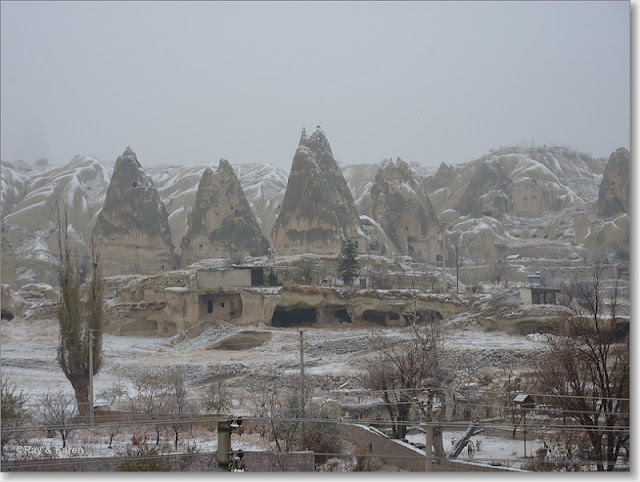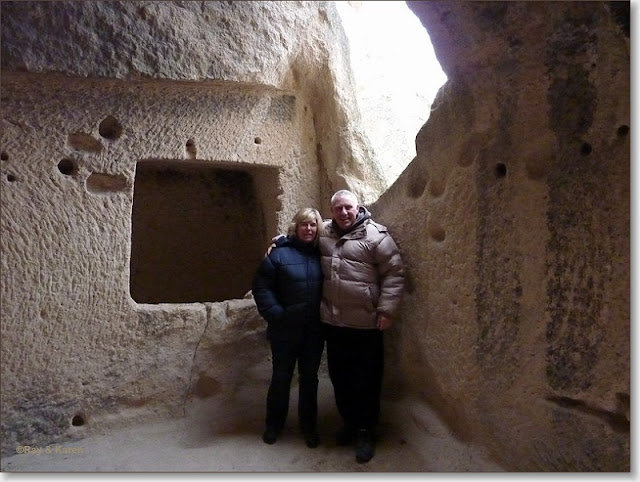Wednesday 16th Nov.
At 5am we were rudely awaken by the sound of Karen’s mobile phone making the sound of a cockerel. ...Very Very loudly. This was in itself not a problem. The problem was that we could not turn it off. Having never had to do it, we did not have clue how to work the damn thing. It was so bad that in the end that in our rattled slumber, I ended up taking the battery out. That did it.
We roused and opened the door only to find that the previous nights clear sky had turned to a complete white out with the fog/cloud layer only about 30m above us and about 1” of snow on the ground with it still gently snowing. Not a good recipe for ballooning.
 |
| It was darker than this photo suggests...and cold too |
 |
| We had to laugh at the situation |
Ever optimistic we dressed etc and then walked the 100m to the balloon office and swallowed 2 cups of their coffee whilst the pilot, that we had been in the bar with last night, drove around the potential take off sights to see if it was feasible to fly. The result was not good. We waited about an hour and there was still no improvement so it was called off for the day. We booked in for the next day and went back to crawl under our rock and back to bed for an hour or so.
One thing we did find out was that the place we were looking for yesterday morning , Pasaberg, has two locations and guess what; we went to the wrong one. There is another one near Goreme. Hopefully we will find it today.
The geology of Capadocia is purely volcanic. This can even be seen inside our hotelroom/church where the larger nodules of ash can plainly be seen in the carved out walls and ceiling.
This was gleened from a website:
Cappadocia is a small area in Central Turkey covering around 300 square kilometers which has a unique, almost surreal, landscape. Volcanic activity formed a plateau of ash and the strange, rugged rock formations were created by the forces of erosion. The unusual structures were formed by the softer ash layers eroding faster than the harder layers of basalt and andesite which remained on top making the capped cone shapes.
These formations are known as "fairy chimneys" as the early inhabitants of the region believed that humans could not have built them, and as fairies lived under ground, they must be the chimneys sticking out.
The tufa ash was easy to work with primitive tools and countless cave dwellings and churches were cut into the cones and valley walls. Underground cities were also built, some believe they date back 4000 years, and these were extended and made more complex over the generations.
With the cancellation of thr balloon we went out shopping, mainly for Leon as we cannot get cat food locally. This is likely as most of the cats are fed from scraps and do not need shop bought food. Anyway, then we decided to go visit an underground city about 20km South at Kamaki. There are many of these cities in the region.
Apparently, the Kaymakli people carved their homes in the underground city tunnels for security reasons. The city has 8 storeys and 5000 people can live in it, 4 storeys are still open now and the deepest point currently is 20 meters below the surface.
The city was built around a main ventilation chimney. Ventilation system was so successful that even now it is not a problem 4 floors down. The city contains all housing conditions for temporary housing. There are living rooms, bed rooms and halls connected to each other with narrow corridors, wine tanks, water cistern, kitchen and food stores, ventilation chimneys, water wells, churches and large lock stones for protection from danger outside.
The first floor was used as an animal shelter. This was the norm for the underground cities due to the difficulties in getting animalas down. The second floor has a church with two abscissa and baptism stones front of the abscissas and a cemetery for important persons near the church. Moreover this floor has a big lock stone for close passing. Lock stones are circular with a hole in the middle and can wigh up to 500kg. The labyrinths have secret exit tunnels for escape.
 |
| Entrance to the underground city |
 |
| One of the many many similar chambers |
 |
| Easy to get lost if you do not foillow the arrrows. |
We spent about half an hour in the city but as the view was so limited and photography difficult we cut short our visit.
On exiting the city we were accosted by pushy carpet salesman who saw our landrover and told us we could put one of his silk persian rugs in the back of Gromit - I think not ! He gave us some tourist advice and as a result we decided to visit a local canyon about 40km away.
Above ground was not too dissimilar to underneath.
 |
| There were 5 people on this tractor. The driver, 3 wives and a sprog. Sandy will be impressed. |
 |
| Above ground was a bit like a war zone. |
On the way to the canyon the fog came down again and visibility dropped to about 50m so we abandoned the idea and headed back to Goreme to seek out the elusive Pasaberg. On the way back we saw this lonley fellow crossing the road.
 |
| An old, slow, lonely donkey |
 |
| Our room is the brown door, top left. Or should I say the rock we crawled out from under. |
We found Pasaberg (as least the one we wanted), about 300km from where we thought is was. It was amazing. The pictures speak for themselves.
 |
| Inside andother Christian church. |
 |
| Gromit going exploring. |








No comments:
Post a Comment